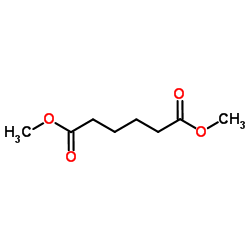Dimethyl adipate

Dimethyl adipate structure
|
Common Name | Dimethyl adipate | ||
|---|---|---|---|---|
| CAS Number | 627-93-0 | Molecular Weight | 174.194 | |
| Density | 1.0±0.1 g/cm3 | Boiling Point | 228.7±0.0 °C at 760 mmHg | |
| Molecular Formula | C8H14O4 | Melting Point | 8 °C(lit.) | |
| MSDS | Chinese USA | Flash Point | 107.2±0.0 °C | |
|
Mixture risk assessment: a case study of Monsanto experiences.
Food Chem. Toxicol. 34(11-12) , 1139-45, (1996) Monsanto employs several pragmatic approaches for evaluating the toxicity of mixtures. These approaches are similar to those recommended by many national and international agencies. When conducting hazard and risk assessments, priority is always given to usin... |
|
|
Carboxylesterase-dependent cytotoxicity of dibasic esters (DBE) in rat nasal explants.
Toxicol. Appl. Pharmacol. 107(2) , 285-301, (1991) Dibasic esters (DBE) are a solvent mixture of dimethyl adipate (DMA), dimethyl glutarate (DMG), and dimethyl succinate (DMS) used in the paint and coating industry. Subchronic inhalation toxicity studies have demonstrated that DBE induce a mild degeneration o... |
|
|
Metabolism of dibasic esters by rat nasal mucosal carboxylesterase.
Drug Metab. Dispos. 19(1) , 124-9, (1991) Inhalation exposure of rats to dibasic esters revealed lesions of the nasal olfactory epithelium similar to those observed with other ester solvents. Female rats are more sensitive to these effects than are male rats. It has been proposed that carboxylesteras... |
|
|
Deposition of dibasic esters in the upper respiratory tract of the male and female Sprague-Dawley rat.
Toxicol. Appl. Pharmacol. 108(3) , 538-46, (1991) Inhalation exposure of the male and female rat to high concentrations of a mixture of the dibasic esters dimethyl succinate (DMS), dimethyl glutarate (DMG), and dimethyl adipate (DMA) results in mild olfactory toxicity. This response is thought to be due to t... |
|
|
Sites and mechanisms for uptake of gases and vapors in the respiratory tract.
Toxicology 160(1-3) , 165-72, (2001) Inhalation is a common route by which individuals are exposed to toxicants. The air contains a multitude of gases and vapors that are brought into the respiratory tract with each breath. Depending upon the physical and chemical characteristics of the toxicant... |
|
|
Induction of heat shock protein 70 in rat olfactory epithelium by toxic chemicals: in vitro and in vivo studies.
Arch. Toxicol. 79(4) , 224-30, (2005) We have previously developed a rat nasal explant system for investigating upper respiratory tract toxicity, and the aims of this study were to determine whether heat shock protein (HSP) 70 is induced in this model following exposure to carbon tetrachloride (C... |
|
|
A microscopic and ultrastructural evaluation of dibasic esters (DBE) toxicity in rat nasal explants.
Exp. Mol. Pathol. 56(3) , 208-18, (1992) Dibasic esters (DBE) solvent has been demonstrated to induce a mild degeneration of the olfactory, but not the respiratory epithelium of the rat nasal cavity following a 90-day inhalation exposure. Previous work has demonstrated that acid phosphatase release ... |
|
|
Lipase-catalyzed dimethyl adipate synthesis: response surface modeling and kinetics.
Biotechnol. J. 5(8) , 848-55, (2010) Dimethyl adipate (DMA) was synthesized by immobilized Candida antarctica lipase B-catalyzed esterification of adipic acid and methanol. To optimize the reaction conditions of ester production, response surface methodology was applied, and the effects of four ... |